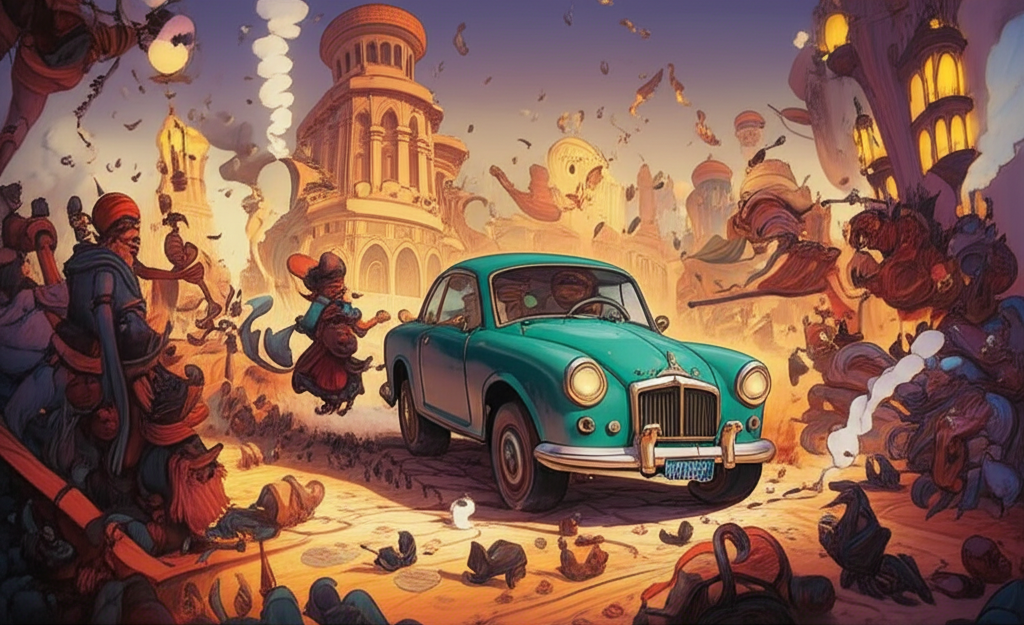
Introduction
From the heart of the Islamic Golden Age, woven into the intricate tapestry of the One Thousand and One Nights (also known as Arabian Nights), comes the haunting tale of the City of Brass. This story is not a historical account but a powerful piece of traditional folklore, a cautionary legend passed down through generations. It originates from the rich oral and written traditions of the Arab and Persian worlds, where storytellers blended adventure, wonder, and profound moral lessons. As an ancient myth, it reflects the worldview and cultural anxieties of its time, serving as a vessel for exploring timeless questions about power, mortality, and the divine.
Origins and Cultural Background
The tale of the City of Brass emerged from a world brimming with intellectual curiosity and spiritual devotion. During the Abbasid Caliphate (roughly 750-1258 CE), cities like Baghdad were centers of learning, where scholars translated Greek philosophy, studied astronomy, and mapped the known world. Yet, this age of reason and science coexisted with a deep belief in a world beyond the seen. The people of this era understood the universe as a place of both divine order and mysterious, untamed forces. They believed in God’s ultimate power, but their folklore was populated with jinn—powerful, often mischievous beings of smokeless fire—and whispered legends of lost cities and pre-Adamic kings who defied heaven. The story of the City of Brass is a product of this environment, a grand adventure into the uncharted deserts that served as a metaphor for humanity’s quest for knowledge and the spiritual dangers that lay in wait.
Character and Symbolism: The City as a Monument to Hubris
The central "character" of this story is not a person but the city itself: Iram of the Pillars, the City of Brass. In the legend, it is described as a magnificent, formidable metropolis, its walls forged from polished black stone and its towers reaching toward the heavens, crowned with gleaming brass that catches the desert sun. It is a place of impossible architecture and silent, breathtaking beauty. However, the city is not a symbol of achievement but of hubris and divine retribution. It represents the pinnacle of worldly wealth and power, a civilization that grew so arrogant in its might that it forgot the transient nature of life and the ultimate authority of the Creator.
Within the narrative, the travelers also seek brass bottles sealed with the signet of the Prophet Solomon (Sulaiman). Trapped inside these bottles are the jinn, figures from pre-Islamic and Islamic lore. Symbolically, these captive jinn represent the taming of chaotic, primal forces by divine will. Solomon’s seal is a potent symbol of wisdom and God-given authority, demonstrating that even the most powerful entities are subject to a higher order. The city, therefore, stands as a monument to those who failed to learn this lesson, while the bottles serve as a reminder of the power of faith and submission.
Main Story: The Expedition into the Sands of Time
According to the legend, the story begins in the court of the Caliph Abd al-Malik ibn Marwan in Damascus. A man from the deserts of Yemen presented the Caliph with a strange brass bottle he had found while digging. When the seal of Solomon was broken, a fearsome jinn emerged, proclaimed its defiance, and vanished into the sky. Intrigued and desiring to find more of these artifacts, the Caliph commanded his governor in the region of Basra, Musa ibn Nusayr, to launch an expedition to find the fabled City of Brass, where it was said many such bottles were hidden.
The governor gathered his most capable men and sought the counsel of a wise old sheikh named Talib ibn Sahl, a man who had spent his life studying ancient texts and maps. Talib, though frail, agreed to guide them, for he knew the legends and the dangers of the great desert. Their caravan set forth from the fertile lands of Basra, a long train of camels and soldiers plunging into the vast, unforgiving emptiness of the Rub’ al Khali, the Empty Quarter.
For weeks, they traveled through a landscape of shifting dunes and stark, sun-baked mountains. The journey was fraught with strange encounters. They came upon a black palace built of hewn stone, guarded by a silent, petrified horseman. An inscription on the statue warned travelers not to be deceived by wealth, for it could not save a soul from death. Inside, they found treasure beyond imagination, but also the grim sight of its former inhabitants, perfectly preserved corpses seated around a feast that had turned to dust. The Emir Musa ordered his men to take nothing, for the palace was a clear lesson in the vanity of worldly goods.
Pressing on, guided by Talib’s ancient knowledge, they finally saw it on the horizon: the City of Brass. Its walls were immense, smooth, and black, without any gate or opening. Its brass towers glittered like malevolent stars under the desert sun. A profound, unnatural silence hung over the city. The Emir ordered his men to find an entrance. One by one, brave warriors attempted to scale the walls using grappling hooks. Yet, as each man reached the parapet, he would stand, laugh maniacally, and hurl himself to his death inside the city. It was as if an unseen force was luring them to their doom.
After several tragic losses, the wise Talib suggested they build a tall ladder from wood they carried. Two of the most pious and steadfast men were chosen to ascend. Shielding their minds with prayer, they reached the top and were able to resist the city’s siren call. From the wall, they lowered ropes and allowed the Emir and his party to enter.
What they found inside was a scene of chilling, opulent stillness. The city was perfectly intact. Its markets were filled with shops where merchants, their bodies now skeletal but still clothed in finery, sat before wares of silk and jewels. In the courtyards, fountains stood dry, and in the lavish homes, families were frozen in their final moments, their riches piled around them. It was a city of the dead, a museum of a civilization that had expired in an instant.
They eventually reached the grand palace and entered the queen’s throne room. There, upon a magnificent throne, sat the city’s last ruler, a queen adorned with pearls and diamonds. Her body was undecayed, preserved by some unknown artifice, but her eyes were hollow. On a plaque at her feet was an inscription, a final, desperate message to any who might one day find her silent kingdom. It told the story of her people, who had amassed all the wealth in the world but were struck by a great famine. In their arrogance, they believed their gold could save them, but they starved amidst their treasures. Her final words were a powerful warning: “Look upon me and take heed. For I gathered treasures and built castles, but they could not protect me from the decree of fate. Where is my army? Where are my guards? Death came for us all. Let the one who sees me not be tempted by the world, for it is a fleeting abode of sorrow.”
Humbled and awestruck, the Emir and his men explored further, finding the brass bottles containing the jinn as the Caliph had commanded. They took only these and departed the silent city, leaving its treasures and its dead to the sands of time. They returned to Damascus not as conquerors, but as changed men, bearing a story far more valuable than any gold: a profound lesson on the fragility of life and the ultimate futility of earthly power when measured against eternity.
Symbolism and Meaning
For the ancient people who told and heard this story, the City of Brass was a powerful morality play. It served as a stark memento mori—a reminder that death comes for everyone, from the lowliest beggar to the mightiest emperor. The central theme is the vanity of human ambition when it is not tempered by piety and humility. The city’s inhabitants had everything the material world could offer, but it brought them no salvation. This message was particularly relevant for the powerful caliphs and emirs of the time, serving as a cautionary tale against tyranny and godlessness. The story reinforced the Islamic principle that true wealth lies not in gold and palaces but in faith and good deeds.
Modern Perspective
The legend of the City of Brass continues to captivate the modern imagination. Its influence can be seen across contemporary fantasy literature, film, and gaming. Author S.A. Chakraborty’s best-selling Daevabad Trilogy is directly inspired by the tale, reimagining the City of Brass as a vibrant, magical metropolis of jinn. In tabletop role-playing games like Dungeons & Dragons, the "City of Brass" is a well-established location on the Elemental Plane of Fire, the domain of the powerful efreeti (a type of jinn). These adaptations often focus on the city’s magical and adventurous elements, but the core themes of lost glory and ancient power remain. In cultural studies, the story is analyzed as a fascinating example of how a society grapples with concepts of empire, mortality, and the divine through folklore.
Conclusion
The tale of the City of Brass is a timeless piece of cultural heritage, a testament to the enduring power of storytelling. It is crucial to remember that this is a mythological narrative, not a factual account or a religious text to be believed. As Muslims, we recognize that only Allah is the true Creator and Sustainer, the sole power in the universe. Stories like this one, however, are invaluable windows into the past. They reveal how ancient cultures used the power of imagination to explore life’s deepest questions, to teach moral lessons, and to make sense of a world filled with both wonder and peril. The silent, glittering towers of the City of Brass remain a haunting and beautiful symbol of this rich human tradition.





